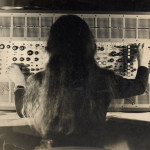Photo of Millennium Tower in San Francisco, 2019.
Courtesy San Francisco Art Institute. Photo Robert Canali.
Postcommodity’s Sound Piece Broadcasts the Millennium Tower’s Collapse – ARTnews.com
[ad_1]
San Francisco’s Millennium Tower is sinking. It has been since the 58-story skyscraper opened in 2009, though engineers only became aware of the issue a year later. To date, the tower has sunk 17 inches and tilted another 14 inches to the northwest. Residents fear for their safety, and many have sued Millennium Partners, the developers, for depreciated home values. (The most visible lawsuit was filed by former 49er Joe Montana, whose tenancy was tied up in an agreement to help market the building.) The sinking has generated a host of problems that wouldn’t be out of place in a horror movie: weird smells, uneven floors, cracked walls, and a hole in a window on the thirty-sixth floor. Millennium Tower has become a symbol of all that has gone wrong with San Francisco over the last decade, when the unholy alliance of luxury real estate and a booming tech economy made the city unaffordable for most. There could be no more perfect object of schadenfreude.
Recognizing the Millennium Tower’s metaphoric and material potential, artists Cristóbal Martínez and Kade L. Twist, who collaborate as the collective Postcommodity, have created an installation that makes the building’s miniscule shifts audible while conceptually recasting its role in the urban landscape. The Point of Final Collapse (2019–) uses data from a continuously updated map of the tower’s movements to generate sound meant to induce the tingling feeling of autonomous sensory meridian response (ASMR). Every day at 5:01 p.m., the ever-evolving composition is broadcast in four-minute snippets from the tower at the San Francisco Art Institute (SFAI) to the surrounding North Beach neighborhood through long-range speakers. As suggested by its title, the piece will continue until the Millennium Tower is fixed or torn down.
Late on a drizzly Sunday afternoon, I made the 35-minute walk from Millennium Tower to SFAI to hear for myself what the glacial pace of structural failure sounds like. Turning from Columbus Avenue onto Chestnut Street at two past five, I wasn’t sure what I would hear. The bells of nearby Saints Peter and Paul Church had just stopped tolling when a sound emerged above the surrounding buzz of traffic and street noise, clear yet still distant, like a far-off stadium concert. There were a few bursts of static, like from a walkie-talkie. A heavily accented female voice said a few phrases that I couldn’t make out, followed by a quick fanfare of what could have passed for whale song. And then it was over. I thought that a nearby couple stopped to listen with me, but it turned out they were merely angling for a good selfie with the fog-enshrouded moon.
Like the Long Now Foundation’s 10,000 Year Clock—another conceptual timepiece with a local pedigree, albeit one that is still under construction—The Point of Final Collapse plays with scale to make tangible ongoing phenomena that are otherwise difficult to grasp in their totality. Just as Millennium Tower’s shifts are unobservable to the naked eye (or ear), so too is it impossible to ever hear the composition generated by the building’s movements in its entirety. At the same time, data visualization, or sonification in this case, is only as effective as the creative choices behind it. Despite the connection to ASMR, the experience of The Point of Final Collapse only faintly recalled that of watching ASMR videos, where women tinkle jewelry or brush their hair into a mic to give viewers a tingling feeling that some claim helps relieve stress and anxiety. Personally speaking, I find that ASMR is most palpable when the sounds that provoke it are heard on headphones. ASMR videos heighten the privacy of this acoustic experience by showing the person who generates the sounds (usually a woman) and who, speaking to the camera, directly addresses the listener/viewer on the other side of the screen.
The Point of Final Collapse opens up this dynamic from the individual viewer to any passerby. It transforms a performance of intimate caregiving into a kind of sonic amuse-bouche for the masses. There is an incipient class critique in this move, one underscored by Postcommodity’s choice of playback hour. “Our goal was to create a moment of repose, of thoughtfulness, a call to prayer,” Twist said in an interview with Hyperallergic. “A lot of things happen at five—you get off work, happy hour starts, it’s like this first moment of freedom, and everybody’s mindset changes—you’re thinking about family, you’re thinking about everything but work. It’s rush hour, and it’s the noisiest time of day.” But if the ASMR signal drifts away into the ether how does anyone get goosebumps, let alone the inspiration to ameliorate the ills wrought by private property?
By broadcasting the death rattle of one of San Francisco’s most tragicomic indices of income inequality as the sound of internet-based self-care, Postcommodity seems to suggest that any collective response to such knowledge is always attenuated through the re-centering of and catering to the individual. We can see the symbolism in the Millennium Tower’s sinking and rightly relish in the resulting travails of those now tied to this folly. But the structural conditions that have contributed to this new era of Manhattanization in San Francisco feel beyond our capacity to change. At the same time, by transmitting the time scale of the Tower’s demise as audio that likely won’t induce ASMR despite being engineered to do so, The Point of Final Collapse also logs how we affectively experience the present as a kind of endless limbo. Lauren Berlant in Cruel Optimism calls this “crisis ordinariness,” a condition in which we are forever awaiting for some pivotal event to shock us into change. For Berlant, the present often seems, “virtually ahistorical, fleeting, fantasmatic, or a space of symptomatic pseudoactivity.” Yet, Berlant goes on to argue, it is precisely because we register the present so fleetingly that we remain skeptical to the phenomena we feel, be that anger over income inequality or our efficacy to address it collectively. It can be argued that ASMR audio is the Muzak of this eternal present, an antidote to and symptom of its attendant anomie. It makes the listener literally feel something while providing further, momentary insulation from the ongoing crisis of our now. With its ephemeral audio trailing off in perpetuity, The Point of Final Collapse plays both sides.
Thinking back to my experience of the piece, I wonder what the selfie-taking couple near me had heard. Did the sound register as alien? Did it register at all, or did it merely blend in with the surroundings? I had expected the sound to be louder, somehow more arresting despite ASMR’s supposed soothing qualities. By my audit, there seems to be enough ambient noise along Columbus Avenue—the main artery of North Beach, which the base of Chestnut abuts—to present a potential buffer. At the same time, it is fair to suppose that atmospheric conditions may change how and from how far away the piece can be heard. I would like to imagine that if I can find the pockets where it is clearest I will come upon other listeners, stunned silent. But I may not have much time to test that hypothesis. In September, the city endorsed a multimillion dollar plan to fix Millennium Tower’s foundation. In the meantime, as tourists beat the rush in overpriced trattorias and ear pod–wearing workers exit the Financial District en masse, The Point of Final Collapse will continue sounding its lossy klaxon, an emergency broadcast system for a crisis already well underway.
[ad_2]
Source by [author_name]
















